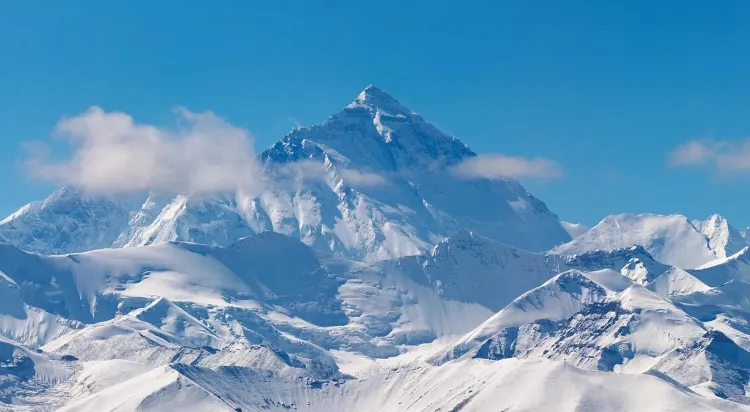The Himalayas: Majestic Peaks and Mystical Landscapes...!!!
The Himalayas, often called the "Roof of the World," are a majestic mountain range spanning five countries: India, Nepal, Bhutan, China, and Pakistan. This awe-inspiring range boasts some of the world's highest peaks, including Mount Everest, the tallest mountain on Earth. The Himalayas are not just a geographical wonder; they hold immense cultural, spiritual, and ecological importance.

Geographical Extent and Formation
The Himalayas stretch approximately 2,400 kilometers from the Indus River in Pakistan in the west to the Brahmaputra River in the east. The range is divided into three parallel zones: the Greater Himalayas (Himadri), the Lesser Himalayas (Himachal), and the Outer Himalayas (Shiwaliks). The Greater Himalayas contain the highest peaks, with Mount Everest (8,848 meters) being the most notable.
The formation of the Himalayas began around 50 million years ago when the Indian Plate collided with the Eurasian Plate. This tectonic activity uplifted the Earth's crust, creating the towering peaks and deep valleys that characterize the range. This process is ongoing, with the Himalayas continuing to rise by a few millimeters each year.
Natural Beauty and Biodiversity
The Himalayas are celebrated for their stunning natural beauty, featuring snow-capped peaks, lush valleys, dense forests, and glacial rivers. The range is home to a diverse array of ecosystems, from subtropical forests at lower altitudes to alpine meadows and tundra at higher elevations.
The biodiversity of the Himalayas is remarkable, with numerous endemic species of flora and fauna. The forests are inhabited by iconic animals such as the Bengal tiger, snow leopard, red panda, and Himalayan black bear. Birdwatchers can spot various avian species, including the Himalayan monal, Nepal's national bird, and the vibrant blue whistling thrush.
Cultural and Spiritual Significance
The Himalayas hold deep cultural and spiritual significance for the people living nearby. The range is considered sacred in several religions, including Hinduism, Buddhism, and Jainism. Many pilgrimage sites and monasteries nestled within the mountains attract devotees and spiritual seekers from around the world.
In Hinduism, the Himalayas are revered as Lord Shiva's abode and the site of many sacred rivers, such as the Ganges, Yamuna, and Saraswati. The Char Dham pilgrimage, which includes the temples of Badrinath, Kedarnath, Gangotri, and Yamunotri, is a significant spiritual journey for Hindus.
Buddhism also has deep roots in the Himalayas, with numerous monasteries and stupas dotting the landscape. The region of Ladakh in India, the kingdom of Bhutan, and the Tibetan Plateau are notable centers of Buddhist culture and practice. The ancient city of Lhasa, home to the Potala Palace, is a significant pilgrimage site for Tibetan Buddhists.

Adventure and Tourism
The Himalayas are a magnet for adventurers and nature enthusiasts. The range offers a plethora of activities, including trekking, mountaineering, skiing, and river rafting. Trekkers can explore famous trails like the Everest Base Camp trek, Annapurna Circuit, and the Markha Valley trek, each offering breathtaking views and unique cultural experiences.
Mountaineers from around the world are drawn to the challenge of scaling the Himalayan peaks. Mount Everest, Kanchenjunga, Lhotse, and Makalu are among the coveted summits that climbers aspire to conquer. The region also hosts numerous adventure sports, such as paragliding in Bir Billing and white-water rafting on the Ganges and Zanskar rivers.
Environmental Challenges and Conservation
Despite their grandeur, the Himalayas face several environmental challenges, including climate change, deforestation, and glacial melting. Rising temperatures and changing precipitation patterns have led to the shrinking of glaciers, which serve as crucial water sources for millions downstream.
Deforestation and habitat loss pose significant threats to the region's biodiversity. Human activities, such as agriculture, logging, and urbanization, have encroached upon natural habitats, endangering many species. Conservation efforts are underway to protect the fragile ecosystems and promote sustainable development in the region.
Several national parks and wildlife sanctuaries, such as Jim Corbett National Park in India and Sagarmatha National Park in Nepal, have been established to safeguard the natural heritage of the Himalayas. Additionally, international collaborations and community-based initiatives are working towards preserving the unique landscapes and cultural heritage of the region.
The Himalayas, with their majestic peaks, diverse ecosystems, and profound cultural significance, are a testament to the beauty and complexity of our natural world. As a source of inspiration and awe, they continue to captivate the hearts and minds of people worldwide. It is imperative that we strive to protect and preserve this extraordinary mountain range for future generations to cherish and explore.
What's Your Reaction?
















